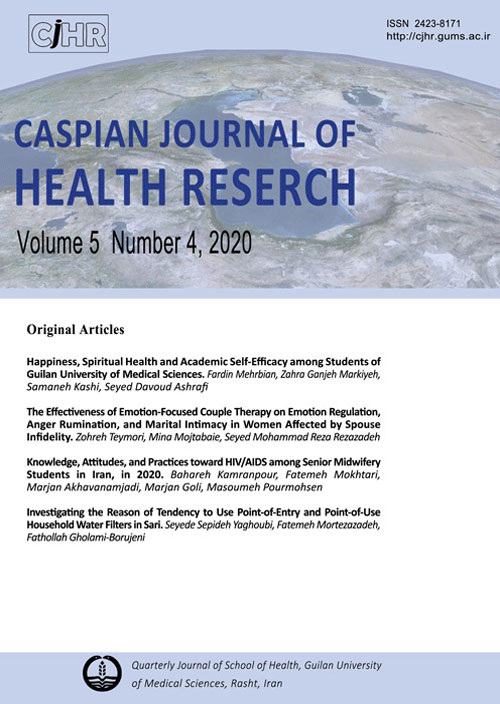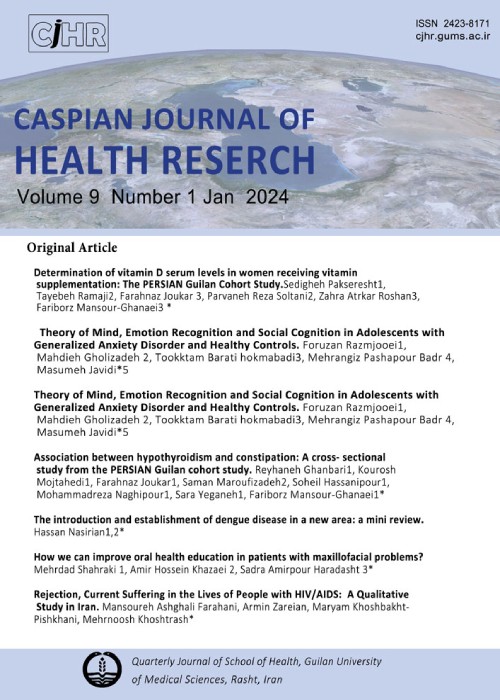فهرست مطالب

Caspian Journal of Health Research
Volume:6 Issue: 1, Mar 2021
- تاریخ انتشار: 1400/04/27
- تعداد عناوین: 4
-
-
Pages 1-8Background
Cardiovascular disease incidence is rising in Nigeria. This study was done to identify cardiovascular risk factors and assess the 10-year cardiovascular risk score of healthcare workers of a tertiary hospital in south-western Nigeria.
Materials & MethodsIn this cross-sectional study, apparently healthy workers of a tertiary hospital in Nigeria were studied. Fifty-two individuals were recruited into the study. Anthropometric measures, blood pressure, fasting lipid profile and HbA1c were obtained using the standard protocols. QRISK3 score was also calculated.
ResultsThe Mean±SD age of participants was 44.9±8.1 years. Dyslipidaemia was the most common risk factor among apparently healthy healthcare workers, while glucose intolerance was the least common. Also, 48.1% of the subjects had at least one cardiovascular risk factor and 15.4% had 3 or more cardiovascular risk factors. The 10-year cardiovascular risk using QRISK3 was moderate in 3.8%. There was no statistically significant difference in the 10-year cardiovascular risk score between the clinical and non-clinical healthcare workers (P=0.313; t=0.819). However, male participants had a significantly higher 10-year cardiovascular risk score compared with the females (3.50 vs. 1.56; P<0.001; t=3.741).
ConclusionCardiovascular risk factors are prevalent among health workers and closer attention needs to be paid to these factors by the hospital management to mitigate cardiovascular disease among the staff.
Keywords: Cardiovascular risk factors, Health workers, Tertiary hospital, Nigeria -
Pages 9-20Background
Despite the recommendations to follow guidelines for the prevention of COVID-19, different communities do not completely adhere to these guidelines. The aim of this study was to explore the barriers and facilitators of the adherence of the people of Sanandaj to the COVID-19 prevention guidelines.
Materials & MethodsThe present study was a qualitative content analysis study conducted in 2020. A purposive sampling method among the residents of Sanandaj, Iran was applied and continued until data saturation was achieved. Twenty semi-structured interviews were conducted with the participants. A verbatim transcription of interviews was analyzed through qualitative conventional content analysis.
ResultsParticipants included 12 men and 8 women. Data analysis yielded 8 categories and 26 sub-categories regarding the barriers and facilitators of the participants’ adherence to the COVID-19 prevention guidelines. The barriers included myths, being under pressure, and letting and facilitators included awareness, fear, commitment, unity against the disease, and warnings.
ConclusionAccording to the findings, it is necessary to correct people’s beliefs, support them, and continue to make them informed about the disease. Increasing awareness and commitment, strengthening the spirit of unity among people, and increasing the level of warnings can be effective in increasing adherence of people to the COVID-19 prevention guidelines.
Keywords: COVID-19, Prevention, control, Persons, Qualitative research -
Pages 21-28Background
Given the importance of using the Coronavirus disease 2019 (COVID-19) vaccine in the control and prevention of this disease, the aim of this study was to investigate the attitudes of Iranian medical and healthcare professionals regarding COVID-19 vaccination.
Materials & MethodsThis cross-sectional study was conducted in August 2020. The target population was professors and researchers of Iranian universities of medical sciences. Data were collected using a questionnaire designed in a study on mapping global trends in vaccine confidence. The participants were invited through an online invitation to respond to the questionnaire. Data were analyzed using descriptive statistics and compared using the Chi-square test.
ResultsOut of 16500 invitations, 918 subjects participated in the study. Most of the participants were female (55.7%). Almost 51% of participants had a PhD degree. The results showed that 46.3% were not sure about the effectiveness and safety of the COVID-19 vaccine. The majority of participants (67.2 %) responded that the country has to provide the vaccine for free rather than paying the cost of the vaccine. Moreover, 73.0 % preferred the COVID-19 vaccine made in a foreign country to the COVID-19 vaccine made in their own country. The United States followed by Germany have been selected by most Iranian researchers to produce the COVID-19 vaccine.
ConclusionThis study showed the high importance of creating a culture and raising the level of awareness and knowledge of the people before the preparation and distribution of the COVID-19 vaccine in the community.
Keywords: COVID-19, Coronavirus, Vaccine, Attitude, Viewpoint -
Pages 29-36Background
Environmental characteristics, as well as the quality of health care services provided to older adults group, are among significant determinants of elderly quality of life. The present study was done to assess the quality of services delivered to elderly residents in nursing homes located in Tabriz, Iran in 2019.
Materials & MethodsThis cross-sectional study was conducted on the elderly living in nursing homes in Tabriz, Iran, of whom 74 residents met the inclusion criteria and were included. The researchers referred to the nursing homes and recruited the participants with regard to the inclusion and exclusion criteria.
ResultsOut of the 74 older adults, 35 and 39 cases were respectively male and female. The largest age group (43.2%) was related to those between 60 and 69 years old. Also, 71.6% of the elderly had been residing in nursing homes for 6-20 months. The rate of service quality in terms of the medical, psychological, welfare, and social domains was 66%, 48%, 68%, and 65%, respectively. Besides, no significant relationship was observed between demographic variables and total scores of service quality (P>0.05).
ConclusionPaying attention to psychological services, including providing counseling and social work services, adapting the centers, and creating recreational departments can lead to an increase in psychological quality and ultimately, overall service quality.
Keywords: Quality of Health Care, Elderly, Nursing homes


